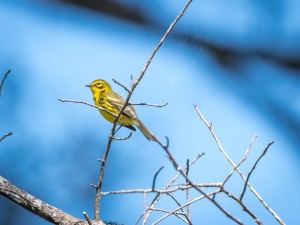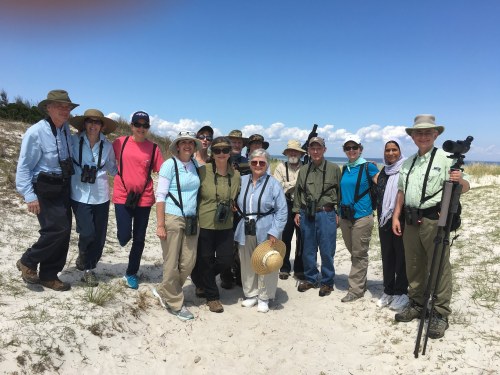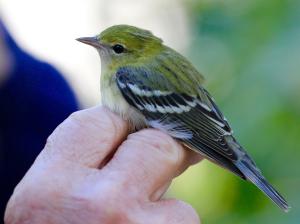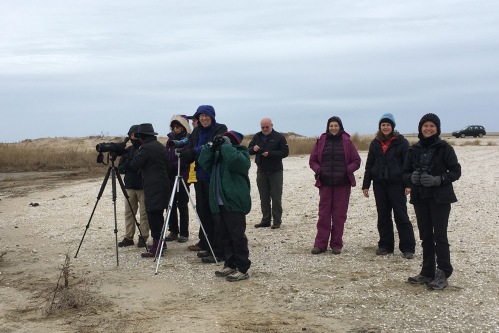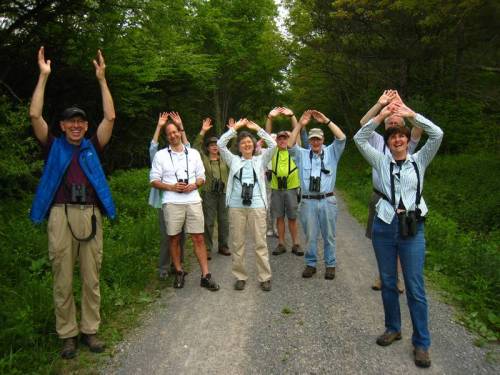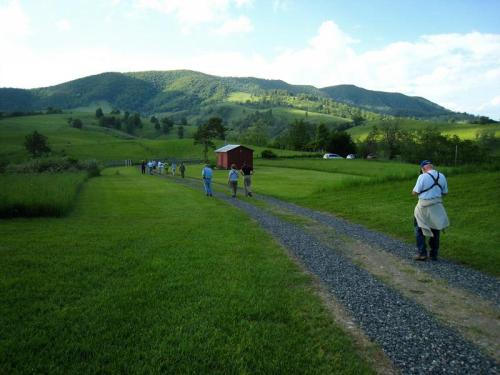Birding in the Fog, May 22-24, 2022
Sunday
Ah, cell service? Nope, non-existent at the visitor center when we arrived at 10 o’clock on Sunday morning. We were unable to reach one member of our group who wasn’t arriving until lunch.
The weather was beautiful, though, for a walk on the .8 mile Elk Run Trail loop. We heard our first Cerulean as well as Hooded and Blackburnian Warblers. We then drove to the picnic area for a peaceful lunch along the creek there.

After lunch we went to the Flat Top and Falling Waters Cascades trailhead. On our mile long walk we heard a couple more Ceruleans, but we were yet to see one. Several of us heard a beautiful chorus of three Hooded Warblers with one male clearly seen. We left and headed back just in time as an afternoon storm was forecast for 4 o’clock. It came right on time as we were checking into the hotel.
We saw quite a few more common species. Below, an Ovenbird and a male Rose-breasted Grosbeak.


We had dinner at the lodge restaurant where we were entertained by a trio of fiddlers. After dinner we walked around Abbot Lake. It was quite dark so we tried to call a Screech Owl, but no luck. We were startled by a large brown blob (creature) that ran through our group. The ID of the blob is still a mystery.
Monday
Rain was forecast for 11:00 AM. It was cool, but nice birding along Radar Road. We heard Ceruleans but again couldn’t find one. It was difficult seeing birds with the fog.

We saw a beautiful red salamander though (redeft). Shortly after that we were met by a group of researchers who were all headed out in full rain gear, looking for particular species called the Peaks of Otter salamander that is found only in Bedford and Botetourt counties.

Next, we started down Warbler Road. We heard and saw several of the same warblers we’d heard on Sunday. The fog rolled in and unfortunately it started raining shortly after 11:00 AM.
We decided to eat lunch downstairs in the lodge rather than at the picnic area. The fog was so thick we could barely see the lake. After lunch Cynthia tested our birdsong ID skills on the warblers we’d been seeing. Everyone did very well having heard them many times.
With so much fog we decided it would not be worthwhile or safe to drive to the overlooks as planned. Instead, we birded through the meadow, stepping over a little turtle on the path, and into the woods heading toward Johnson’s Farm.

We heard American Redstarts, Hooded and Cerulean Warblers. Then suddenly we heard the clear, loud churee’-churee’-churee’ notes of a Kentucky Warbler right along our path. Catherine spotted it and a couple of us got a really good unobstructed view of it sitting out on a branch, but then it flew. Not giving up we followed it through the small patch of woods to the meadow on the other side. The bird was in a large tree singing away. We then spent an hour and 15 minutes searching for a bird that was right overhead, singing loudly and repeatedly, but the fog was dense. Don said he looked at every leaf on that tree. We didn’t find it.
We took a break out of the rain at the visitor center and did charade-like imitations of birds to entertain ourselves: hummingbird, bittern, Louisiana and northern waterthrushes, crane, woodpecker and others. We walked around the lake in the rain with the goal of finding just one more species. We did find Cedar Waxwings. They, along with Eastern Phoebes and Barn Swallows (photo on right), didn’t seem to mind the rain at all.
Tuesday
Since it was raining steadily at 7:00 AM, we decided to wait and hope it would let up. Some of us had breakfast at the lodge restaurant while we waited. About 8:30 four of us decided to head back toward Johnson Farm in light rain in search of the Kentucky Warbler. We found it again in the same location. Becky spotted it and a couple more of us got a good look at it. We continued on to the farm, but the birds were not very active so we headed home.

In spite of the weather everyone was in good spirits the whole time. It was a light hearted crew providing me a memorable experience in leading my first Forsyth Audubon trip.
Thanks to Barb Barucki and Cynthia Donaldson for sharing some of the photos used in this story.



















































